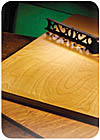
Last month in part three, we reviewed the non-added formaldehyde composite wood panel products currently and formerly available on the market. In part two, we saw how "tight construction" has increased energy efficiency while trapping pollutants indoors and we also saw how a new product from Roseberg Forest Products, SkyBlend, makes uses of the "lesser of two evils"-phenol formaldehyde (rather than urea formaldehyde as a binder). We started the series with a look at the mixed results when agricultural fibers were substituted for wood fibers in the manufacturing of composite wood panel products, such as medium-density fiberboard and particleboard, as well as substitute binder (adhesive) formulations.
This month, we'll conclude this series with a review of the significant advancements in soy-based resin binder technology with a look at PureBond-a new line of formaldehyde-free hardwood plywood panels from the largest producer of decorative interior panels in the United States, Columbia Forest Products.
Sticky business
Founded in 1957, Portland-based Columbia Forest Products is North America's largest manufacturer of hardwood plywood panels and decorative interior veneers used to produce:- Architectural millwork
- Commercial fixtures
- Fine furniture
- High-end cabinetry
CFP also manufactures and markets engineered and solid wood flooring products in facilities throughout the U.S. and Canada. Used in the majority of domestic, Canadian and imported plywood panels, urea formaldehyde resin is the standard binder for the manufacture of all interior grade plywood panels.
As we saw in part one, 10-plus years of research and development into soy resins has had mixed results and only proved feasible as a partial substitute (50 percent) for UF. This situation got Dr. Kaichang Li, associate professor at Oregon State University, thinking. How was it that mussels could attach themselves so securely and resisting tenaciously-strong currents, wave and tidal action, predators, etc., in the hostile environment of the world's oceans? To find the answer, he studied mussels intensively and found that, by combining an amino acid with soy protein, he could mimic the strong bond of the mussel to the rock.
Three patents later, and after successful testing and proving-out, CFP is adapting Dr. Li's discovery as a substitute, in whole, for UF for all their veneer-core hardwood panels. Made primarily of soy flour, the new binder allows CFP to eliminate UF, a major source of indoor air pollution, completely. Also, when tested for "thickness swell" (effects of water emersion), its performance was superior to UF, thus providing more moisture protection.
Dream Team
The team for the cooperative commercial development of the soy-based resin included Dr. Li and his team at the College of Forestry at OSU, CFP and a resin supplier Hercules Inc. Hercules granted CFP a license to utilize the soy-based resin adhesive system on an exclusive basis for all CFP North American decorative and panel markets. For the three OSU patents on the adhesive system, Hercules has licensing rights for the patent's duration.
The binder is about 87 percent soy protein-an inexpensive, abundant, renewable agricultural product. The remainder is a proprietary polymer, made from Hercules, supplied polyamide resins having a neutral pH and are:
- Water-based
- Non-toxic
- Non-flammable
When the binder cures only water, vapor is off-gassed. With little-to-no cost premium, the soy-based binder panels are a cost-effective alternative to standard UF-based panels and straw-based panels using an MDI (polyurethane) binder. Neill Kelly Signature Cabinets, the pioneer in environmentally friendly kitchen and bath cabinetry, is using the new CFP panels on a 264-unit high-rise condominium in Portland. They've observed no difference in workability and an absence of any off-gassing-commonplace with UF panels. With MDI experiencing supply shortages, the cost of straw-based/MDI-binder panels is increasing making soy-binder plywood panels even more attractive.
All in the Family
Being inherently water resistant, it is very likely that, eventually CFP will adapt new formulations of the soy resin as a substitute for phenol formaldehyde, used for exterior grade plywood and OSB. In April 2005, CFP announced the conversion of two of its four North American plants (one in the east, one in the west) to soy resin production. By mid-2006, all four plants producing veneer-core panels should be on line and "formaldehyde-free." This is good news for all of CFP's 3,000-plus owner/employees, customers and end-users.At CFP plants, where MDF and conventional particleboard are produced, standard UF binders will be used. At some point in the future, these plants will also be converted to soy-resin binders. Hardwood plywood veneers are also available certified to the Forest Stewardship Council's rigorous standards and CFP offered a veneered agri-fiber-core (made from agricultural waste) panel in the PureBond line.
Unfortunately, the veneered agri-fiber-core panel used was Woodstalk, a straw-based panel product with an MDI (methyl diisocyanate) binder made by Dow BioProducts (a division of Dow Canada). Dow BioProducts ceased producing Woodstalk in December. A popular product among architects and specifiers, CFP is seeking other Ag-fiber panel products to replace Woodstalk.
PureBond formaldehyde-free hardwood plywood panels, using the soy-based binder developed by Dr. Li and his team, won a place on the "Top 10" list of green building products for 2005 from the prestigious Greenspec Directory. BuildingGreen Inc. publishes the directory and the well-respected, advertisement-free monthly newsletter Environmental Building News-the "Consumer Reports" of the green building movement. Dr. Li's insight reminds me of one of my favorite maxims: Every man is my superior, for I may learn from him. In this case, it appears we have the primitive mussel to thank for revealing its secrets to Dr. Li, thus giving him the opportunity to learn from them, making the built environment and our lives, that much healthier.
If you read this article, please circle number 357.




